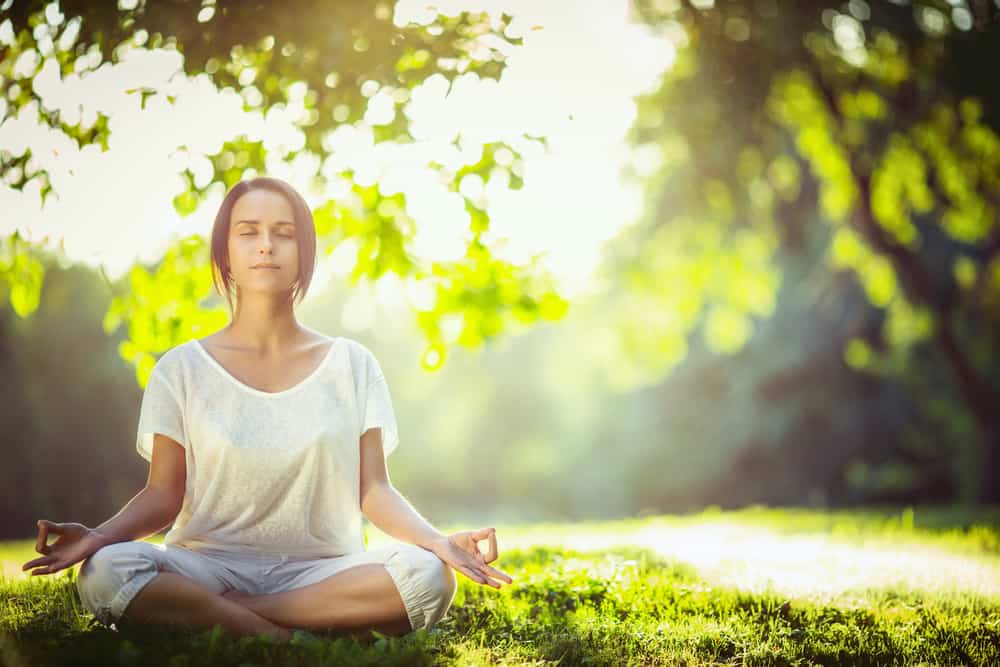Are you suffering from anxiety or depression and looking for a natural way to get fast relief when you feel your intense sadness or low mood (depression), or intense worry (anxiety) escalating? Then you should consider the practice of mindfulness meditation.
Mindfulness meditation is quickly becoming a very popular natural tool for the management of an array of mental health illnesses, including both anxiety and depression. This is unsurprising really, considering mindfulness meditation has an enormous variety of benefits for people struggling with their mental health.
So, you’ve heard the term ‘mindfulness meditation’, and want to give it a shot, but you don’t exactly know what it is, the benefits of it or how to go about practising it. In this article, we will teach you:
– what mindfulness meditation is
– some of the major benefits of mindfulness meditation practice for managing depression and anxiety
– how to prepare for your mindfulness meditation practice
– common mindfulness meditation exercises
Let’s get started.
What Is Mindfulness Meditation?
Mindfulness meditation, a popular form of meditation practised all around the world, can be defined as:
the practice of focusing the mind (meditation) on the present moment (mindfulness).
By bringing our complete attention to the present moment, we are able to detach ourselves from our feelings surrounding low mood or concern. Instead, we are able to peacefully view our feelings “from above” without any judgement and realise they are just that, feelings only ( i.e. they come… and then they go again, they do not define us). Mindfulness meditation can assist us to become more aware of our thoughts, and even more so, can reduce the need for us to react to them immediately.
You may wish to think of this popular analogy – imagine you are sitting, relaxed, by the edge of a gently trickling stream, watching your feelings coming along and then disappearing again, like stray leaves floating their way downstream. As we practice mindfulness meditation (particularly when you are first learning), if we find our mind wanders off, we can gently draw ourselves back to the present moment (e.g. by concentrating on our breath).
The Benefits Of Mindfulness Meditation For Depression and Anxiety
Allows Us To Focus On The Present Moment
As sufferers of depression and anxiety will understand, many feelings of sadness, low mood or worry relate to events that have happened in the past, or events that are yet to occur in the future. By practicing mindfulness meditation, we are able to train our minds not to worry so much about what has already occurred or what is yet to happen, and instead focus only on the present moment. Mindfulness meditation teaches us to focus on ‘the here and now’ i.e. what we can control.
Increases Production Of The Neurotransmitter ‘Serotonin’
Serotonin is a neurotransmitter or ‘chemical messenger’ that is produced in the brain and resides primarily in our digestive tract. Serotonin plays an important role in a variety of activities; specifically, serotonin:
– assists mood regulation and social behaviour
– boosts cognitive function (e.g. learning and memory)
– is important for appetite regulation and proper digestion
– helps us to achieve quality sleep
Low serotonin levels are commonly found in people suffering from depression and/or anxiety. Regular mindfulness meditation practice has been associated with a natural increase in serotonin levels, which is particularly beneficial for stabilising mood in people with depression or anxiety. Increased serotonin levels can result in higher quality sleep, which can lead to reduced feelings of sadness or concern throughout the day – it is no secret we are better able to cope with difficult situations when we feel rested, as opposed to when we are running on an empty tank.
Reduces Stress
Stress (i.e. feeling overwhelmed, tense or worried) is associated with depression and largely associated with anxiety (or chronic worry).
The ‘amygdala’ is the area of the brain responsible for switching on our stress response. Regular mindfulness meditation practice can help us to reduce activity in this part of the brain.
Additionally, people who practice mindfulness meditation regularly are thought to produce lower levels of the commonly known stress hormone ‘cortisol’, compared to people who do not.
Lessens Emotional Reactivity
When we feel depressed or anxious, we are often likely to emotionally react to situations that make us feel upset or distressed, without giving the situation at hand much thought before reacting.
Mindfulness meditation is a fabulous tool for allowing ourselves to view our thoughts and feelings ‘from above’, or like leaves that come and go, travelling downstream (as explained above).
By practicing detachment from our feelings though regular mindfulness meditation, we can reduce our need to emotionally react to a situation, and instead address things cognitively beforehand. Mindfulness meditation encourages us to understand that our thoughts and feelings come.. and then they go again – we do not always need to react to them, and therefore feelings of depression and anxiety may be reduced.
Reduced Rumination
Rumination refers to the process of going over and over a scenario in your head, and is a very common situation when you are suffering from depression or anxiety.
Mindfulness meditation is a great tool for reducing repetitive thoughts and concerns. By practicing mindfulness meditation regularly, you are able to better focus on the task at hand (i.e. the present moment), and are less likely to repetitively worry about something that has happened in the past or something that is yet to come.
Can Assist In Achieving Better Sleep
Sleep disturbances are very common in people suffering from depression and/or anxiety, including struggling to get to sleep, insomnia (the inability to stay asleep or waking numerous times overnight), and even sleeping too much.
Mindfulness meditation can help us to both get to sleep and achieve a higher quality sleep, whether we choose to meditate throughout our day or before we go to bed (or both). A racing mind (anxiety) or feelings of sadness and low mood (depression) often worsen in the evening, or while lying in bed trying to go to sleep.
By practicing mindfulness, we can slow down our thoughts, focus solely on the present moment and rid our mind of the day’s (or the following day’s) stress. Here is a good mindfulness meditation exercise if you feel increased anxiety or depression before sleep:
– Step 1: Gently breathe in for four counts, then hold briefly (one to two counts); now breath out for four counts, and repeat. Once you have your breath under control, you may wish to..
– Optional Step 2: Think of the things that made you feel happy or went right in your day (little or big ‘wins’), or try brainstorming three or more things you are grateful for that day. Gratitude is a powerful tool for increasing happiness and reducing depression and anxiety.
How To Prepare For Your Mindfulness Meditation Practice
Now you have an understanding of what mindfulness meditation is and how it is beneficial for anxiety and depression, let’s talk about some tips to help you prepare for your practice.
There are a few simple things you can do to help you feel prepared before you begin your mindfulness meditation practice, including:
– Step 1: Choose a time of day that suits you to practice. You are more likely to keep up the habit by practicing at the same time each day (where practical). It is also good to have a rough idea of how long you would like to practice for (for example, five minutes, ten minutes, etc.).
– Step 2: Wear something comfortable. Generally speaking, it is easier to relax wearing soft fabrics/items made for relaxing (e.g. loungewear), than it is wearing tight-fitting formal attire. Ensure the temperature of the room/area you meditate in is also comfortable for you.
– Step 3: Find a quiet and peaceful room or area, free from clutter so as not to distract your mind.
– Step 4: Remove any distractions. For example, use the toilet before you start and turn off your phone/any other electronics that may disturb your practice.
– Step 5: Decide on the meditation exercise that is best for you. There are a variety of different ways you can carry out your mindfulness meditation practice. We shall discuss some of the most common and easiest exercises for beginners in the next section of this article. Feel free to focus on one exercise, or differ up your practice with a variety of exercises. It’s all about finding what suits you best.
– Optional Step 6: Light a candle or play gentle instrumental music. If you wish to, burning a candle with a gentle scent or softly playing relaxing instrumental music can help you to feel calm and relaxed.
– Step 7: Sit or lay in a comfortable position. If you choose to sit to meditate, ensure you do so on an even surface with comfortable posture (keep your back straight and relax your neck and shoulders). Whether you choose to sit or lay down, it is best to keep your eyes closed throughout your meditation session. (It’s worth keeping in mind that using the same, cosy spot to complete your meditation may be of benefit to you).
– Optional Step 8: Begin with and keep a relaxed, very gentle smile on your face throughout your practice, regardless of your choice of mindfulness meditation exercise. Give it a shot! See how it makes you feel (it can help you to feel calm and peaceful, as well as heighten your awareness throughout your session).
You are now ready to get started with your mindfulness meditation practice.
Common Mindfulness Meditation Exercises
As you research deeper into the topic of mindfulness meditation, you will find there are a huge variety of different exercises available. We will detail two of the most common mindfulness meditation exercises below, that are a good starting point for beginners. Additionally, we will discuss briefly a third option, whereby we will touch on some of the most popular mindfulness meditation apps for guided meditations.
Exercise 1: Mindfulness Meditation Breathing Exercise
This is a good starting exercise, as your breath is pivotal to many other mindfulness meditation exercises you may come across in future.
– Step 1: Prepare yourself according to the instructions in the above section, ‘How To Prepare For Your Mindfulness Meditation Practice’.
– Step 2: Begin by gently breathing in for four counts, hold briefly (one to two counts), now gently breathe out for four counts. Release any thoughts in your mind, and instead concentrate on your breath – notice the sensation of gently drawing air into your nose or mouth, feel your chest rise as the breath enters your lungs, and then concentrate on the feeling of your breath exiting your body as you gently breathe out. You may wish to think of drawing in positive energy as you inhale, and calmly expelling any negative energy or thoughts as you exhale. If your mind wanders, bring it back to concentrating on your breath.
– Step 3: Repeat this breath cycle ten or more times, as you wish. How do you feel? Lighter, clearer, calmer? Don’t worry if you don’t notice any major changes to how you feel in the beginning – just like most things in life, mindfulness meditation takes practice. The more regularly you practice, the more relaxed you will feel.
Exercise 2: Mindfulness Meditation Body Scan Exercise
This exercise is a great progression from Exercise 1, and is perfect for those days when you are holding a lot of tension in your mind and body, or for before going to sleep. This exercise will help you to increase your body awareness, release any tension and relax more completely.
– Step 1: Prepare yourself according to the instructions in the above section, ‘How To Prepare For Your Mindfulness Meditation Practice’.
– Step 2: Practice briefly the sequence you learnt in Exercise 1 to get your breathing calm and even: i.e. gently breathe in for four counts, hold briefly (one to two counts), now gently breathe out for four counts. Release any thoughts or worries from your mind.
– Step 3: Begin your body scan: Keep breathing calmly as per Exercise 1 and start becoming aware of any sensations in your body.
Start by bringing your awareness to your toes (you may wish to wiggle them). Do you notice any discomfort, tension or other sensation? When you are ready to, as you exhale, gently relax your toes. Once you are satisfied that your toes feel relaxed, move on to your ankles.
Once you have gently released any tension or discomfort from your ankles as you breathe out, you can move onto your calves.
Keep repeating the process of taking a nice breath in and releasing any tension on your out breath, as you work your way up your body (for example, work through from your toes and ankles to your knees, thighs, pelvis, hips, lower back, abdomen/tummy, chest, upper back, shoulders, neck, jaw, ears, eyes, forehead and finally the top of your head (crown)).
Upon completion, your breath should remain calm and even, and your body and mind should feel calm and relaxed.
Option 3: Mindfulness Meditation Smart Device Apps That Include Guided Meditations
Some people find guided meditations via mindfulness meditation smart device apps very helpful and that their mind is much less likely to wander off, thereby enhancing the meditation experience and its benefits.
Some of the most popular and beneficial mindfulness meditation apps available include ‘Calm’ and ‘Headspace’ (see our article ‘The Best Mindfulness & Meditation Apps’ for more information). If you are looking for a solid Australian mindfulness meditation app, you may wish to check out ‘Smiling Mind’ (a free app with Australian voiceovers).
Regardless of your choice of exercise, once you have completed your practice, open up your eyes gently and slowly – this can assist you to readjust to your day comfortably and help you to hang on to that blissful feeling mindfulness meditation can bring.
Some Things You May Wish To Remember
– You can complete your practice anywhere, anytime! At home, in the car, on the train, at your desk on your lunch break… the opportunities are endless! You may also wish to engage your mindfulness meditation skills when you are having a rough moment – you are bound to feel somewhat better afterwards.
– Aim for regular practice, regardless of how long you meditate for! Whether you have time/wish to meditate for two minutes or an hour per day, regular practice can positively affect your life. The most important thing is to practice regularly i.e. once daily (or twice if you wish – it is completely up to you). Practicing every day can greatly assist us when we feel very depressed or anxious and need to draw on the skill of meditation (remember, it is difficult to master the skill when you are feeling awful).
– Don’t worry about achieving the ‘perfect practice’. Your mind is bound to wander, particularly if you are having depressed or anxious thoughts. It is almost inevitable, even for people who have practiced mindfulness meditation for many years. After all, thinking is what our minds do! If you feel distracted by your thoughts as you practice, that’s OK, just gently pull yourself back to concentrating on your breath/body/etc. (depending on the exercise you follow).
As you now understand, mindfulness meditation is a fantastic natural tool you can practise and utilise in your day-to-day life, and when you feeling your depression or anxiety escalating, to help you calm your breath and mind. However, the practice of mindfulness meditation alone is not enough to help you recover from mental illness, and should be used in conjunction with seeking help from a professional therapist. Contact Blissiree Pty Ltd today to help get you on your way with recovering from your depression and/or anxiety.
Alternatively, for more information on how to incorporate mindfulness into your life, visit this page for tips: https://inlpcenter.org/mindfulness-techniques/











